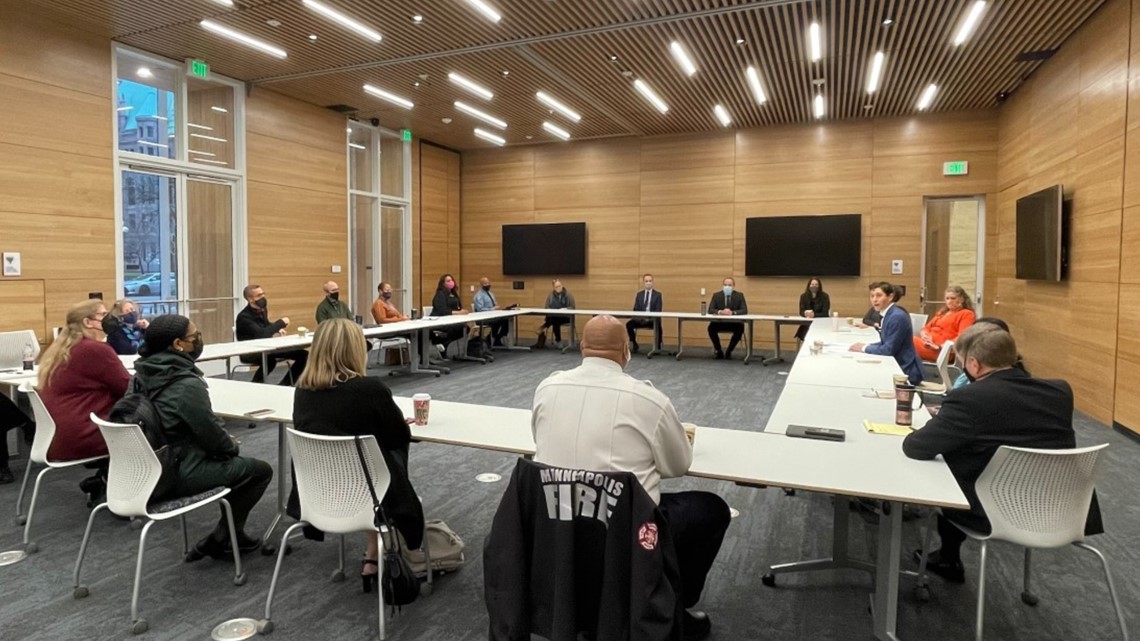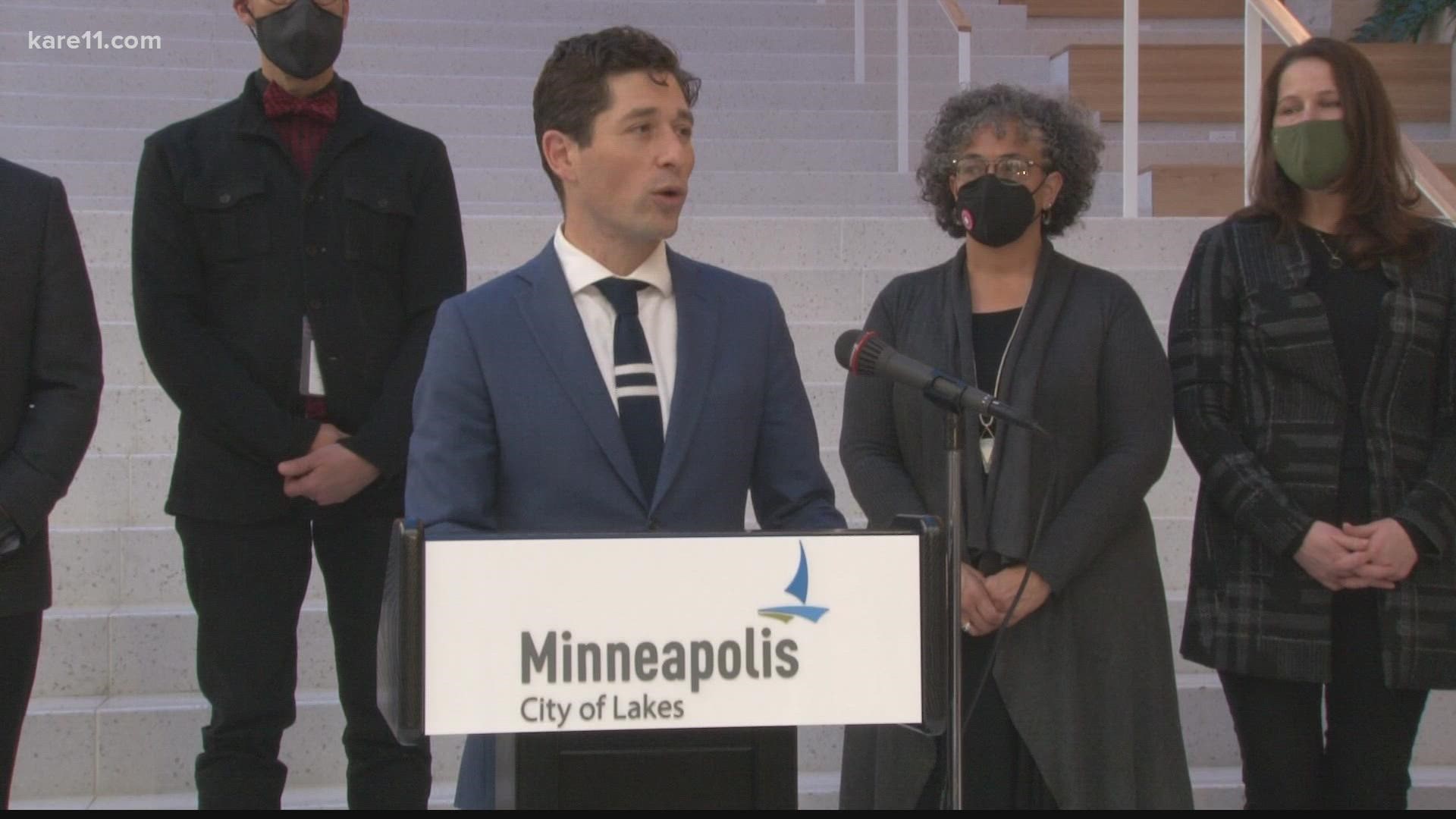MINNEAPOLIS — The mayor gained sole oversight of 10 city departments on Friday for the first time in Minneapolis history, as the "strong-mayor" model of government officially took effect through a change in the charter.
Voters narrowly approved the charter amendment, known as Question 1, during the municipal election last month. On a basic level, the charter now separates the mayor as the "chief executive" and defines the city council as the legislative body.
Mayor Jacob Frey marked the occasion Friday morning by assembling his department heads for a meeting at City Hall. Although he did not reveal many details about their discussions, he said at a news conference later that "this is a structure of government that's about 120 years in the making."


"Mayors from Hubert Humphrey to Don Fraser have fought to ensure that we can have a structure of government that works efficiently and productively for the residents of the city of Minneapolis," Frey said, "that pushes aside the disjoint and confusion and lack of clarity."
Previously, an executive committee that included council members had influence over the nominating and firing of department heads, along with oversight of some day-to-day operations.
R.T. Rybak, who served as mayor of Minneapolis from 2002 to 2014, supported the charter change. In an interview with KARE 11, he said it was difficult under the old structure to retain city employees, since they didn't know who their boss was.
"I remember so many conversations in my office with really talented people," Rybak said, "who just said, 'I can't work in this situation, where I'm working for 14 different people.'"
To illustrate the confusion, he provided an example:
"The fire chief reported to a committee that I sat on. The person who led technology reported to the city coordinator who reported to the committee that I sat on. I nominated them but didn't have them working for me," Rybak said. "It was a really fractured system. What this does now, is clean it all up. They all work for the mayor."
Leading into the election, however, opponents of Question 1 expressed fears that the strong-mayor system would strip power from the council members and their diverse constituents. Ultimately, Question 1 passed by a margin of 52.4% to 47.6%, a difference of only about 7,000 votes.
Critics of the proposal included Robert Lilligren, a former Minneapolis council member.
"My concerns centered around really appreciating the system of government that we had, where we had a city council that collectively acted as an executive within city government," Lilligren said. "That gave someone like me, in the Phillips neighborhood, real access to some authority -- and by extension, the 32,000 people that lived in my ward."
Despite his opposition, Lilligren respected the will of the voters and joined a working group under Mayor Frey to aid the transition.
"I feel sort of a responsibility, an obligation, to be at the table," Lilligren said.
The group has already met twice, Lilligren said, and is studying other strong-mayor cities like St. Paul. They'll deliver recommendations to Mayor Frey after the New Year about how to best implement the strong-mayor model.
The city council also passed legislation last month "directing the City Clerk and City Auditor to identify, evaluate, and report back with recommendations." According to city documents from another workgroup, Duluth and Fresno, Calif., are other cities that Minneapolis may look to for information about the strong-mayor system. Also, city staff listed a number of different lingering questions heading into 2022, such as "what happens with the standing committees and the concept of 'home committees,' where departments report?"
Lilligren, meanwhile, said he's going to focus on retaining some influence for the city council.
"The city council is more strongly defined as the voice of the people," Lilligren said. "For me, it's going to be important to define how that voice comes into actual governance within the new system."
It should be noted that the council still has important powers, like passing ordinances and controlling the budget process. Plus, although they lost influence with the elimination of the executive committee, council members will still cast votes to confirm nominated department heads.
R.T. Rybak said the public should think about the structure like they think about Congress or state government, which has a clear separation of powers.
"I don't think people should overread it. President Biden can't do a whole lot without Congress, Gov. Walz can't do a whole lot without the legislature, and Mayor Frey won't be able to do a whole lot without the city council," Rybak said. "But the people who work for all those people will now finally know who they work for. And that's going to help."
One thing that won't change: the status of Minneapolis Police. The police department, as an exception, was previously beholden to the mayor's office and will continue to operate that way under the new system of governance.
Government structure aside, it's unclear if Chief Medaria Arradondo will continue to lead Minneapolis Police beyond the end of his term in January 2022. He said Friday that he's still discussing his future with his family and plans to make a public announcement next week.

